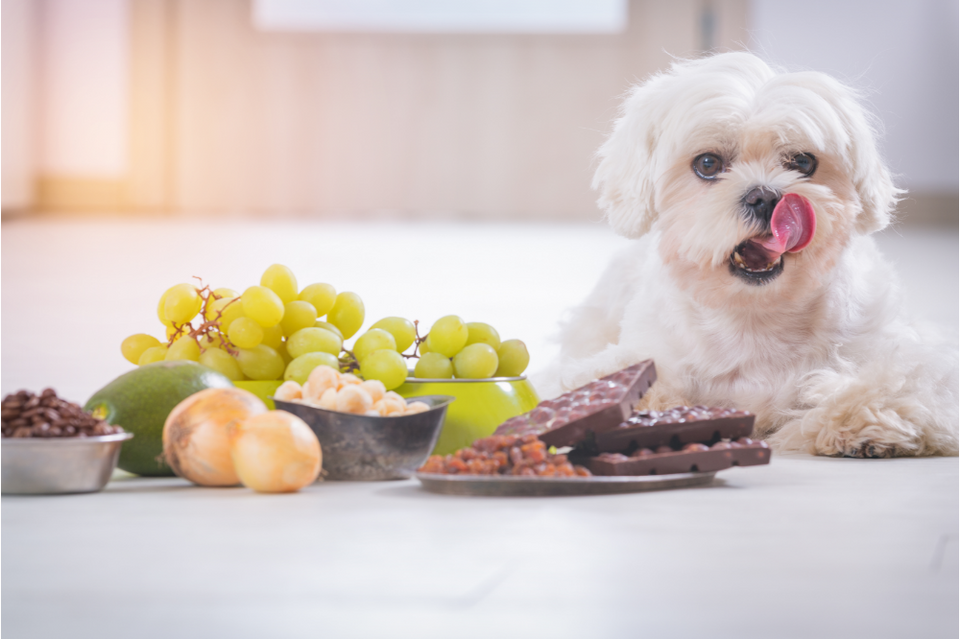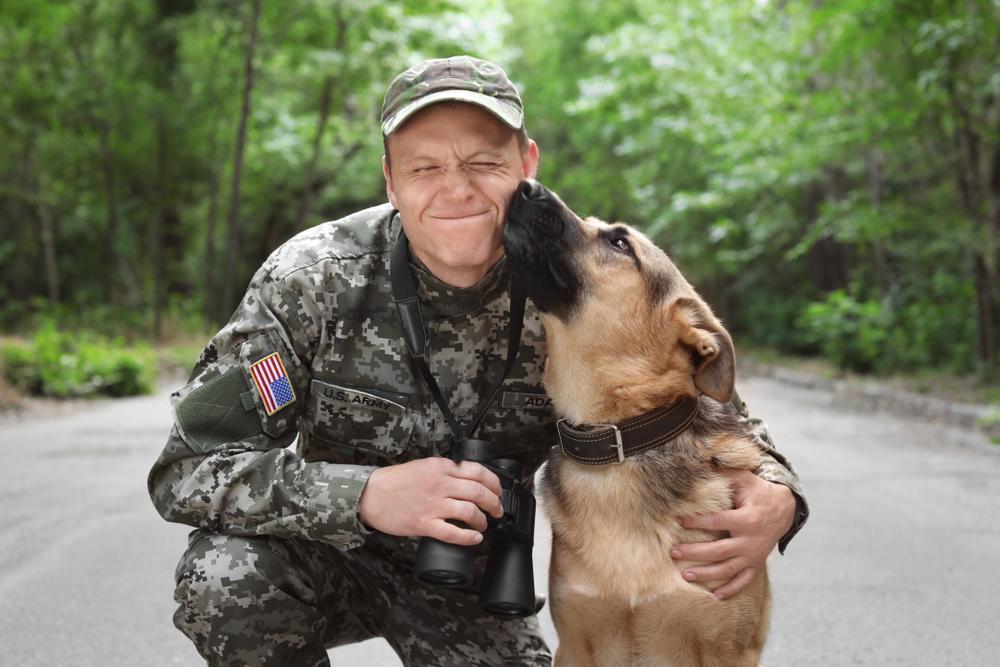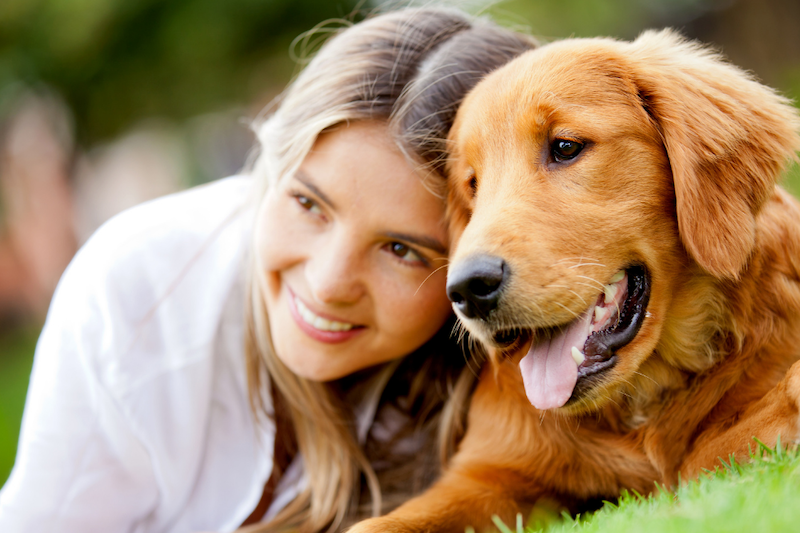
What to Feed Your Dog & What Not to Feed Your Dog

Humans and dogs both love to eat, no doubt about that, and we couldn’t survive without doing it. However, for both species, there are things that are safe and healthy to eat and things that aren’t.
We can see it in humans in cases of lactose intolerance, or allergies to things like nuts, gluten, or shellfish. But there are common everyday things that humans can eat that dogs absolutely cannot. It cuts both ways, though. Dogs are fine if they eat rotting meat or poop. Humans, not so much.
One of the best ways to keep your dog healthy is to feed her the proper diet — and to make sure she doesn’t eat any of the wrong things.
Let’s look at what makes up a proper diet first, since it’s actually a much shorter list.
Finding the right diet

Canine nutrition has become as much of a thing as human nutrition, with very different diets available for each — and many of these are controversial, with supporters and detractors.
For example, there’s the human paleo diet, which recommends only eating what was available to our typical cave-dwelling ancestors. The short version is that it allows foods humans ate when they were hunter-gatherers — meat, fish, berries, fruits, vegetables, nuts and seeds — but it excludes everything that came later, with the rise of agriculture.
So no dairy, legumes, or grains. Again, it’s a controversial diet precisely because of those exclusions.
But this one example is why we have to look at human and canine nutrition in completely different ways. If you wanted to put your dog on a canine paleo diet, then you’d have to feed her live chickens or sending her off with the neighborhood dogs to hunt and kill a deer or other wildlife.
Many people do fine on the paleo diet. Others supplement it with dairy and grain. On the other hand, our dogs can do a lot better than killing live animals and eating them raw. The question really is, “Okay, so what should we feed them?
Best foods: It all depends on the dog
As with many things concerning our fur babies, the place to start is with your veterinarian. A dog’s needs vary depending on a number of factors. Size, breed, energy level, existing medical conditions, and specific nutritional needs all factor into it.
Some dogs can do fine on just kibble while others need wet food. There’s also the whole argument over raw vs. cooked diets, although in the second half of this article, I’ll be looking at the cons of raw diets for dogs (and their side-effects on humans.)
Unlike cats, dogs can subsist on a vegetarian diet, although keep in mind that their digestive system is less-adapted to it than ours.
What to feed your dog...
So what are the best things we can feed our dogs? Here’s the list. As mentioned, it’s a lot shorter than the “do not feed list.”
Boneless, skinless lean meat
This includes chicken, beef, lamb, pork, and turkey — although not ham, because it’s processed, salted, and fattier than pork. Be sure to cook it thoroughly, to the internal temperature recommended on the package, let it cool a bit, and cut it into small pieces before serving it.
Some fresh fruits
These don’t include the ones on the do not eat list, of course. And always use fresh fruit, never canned, since the latter can contain tons of added sugar. Likewise, always wash your fruit to make sure there are no pesticide residues on them — even if they’re organic. Some fruits that are safe for dogs are apples, bananas, blueberries, cantaloupes, mangoes, peaches, and pears. Just be sure to remove any seeds, pits, stems, or leaves first.
Some vegetables
Dog-friendly vegetables include broccoli, Brussel sprouts (if you don’t mind a gassy dog!), carrots, celery, green beans, cucumber, or a plain baked or boiled potato. Never give your dog raw potatoes or let them get ahold of tubers from the garden.
Cooked pasta
As long as your dog doesn’t have any gluten allergies, pasta is a good way to add carbs and some filler to her diet. It’s made with very simple ingredients — flour, water, and eggs — and you don’t need to dress it up with any fancy sauce. In fact, no sauce is better. Red sauces can be too spicy for dogs and white sauces can also have too much fat.
Cooked white rice
Another simple staple that can serve the same purpose as pasta, but be sure to use white rice and not brown. The combination of cooked white rice and boiled chicken can also help make your dog feel better when her stomach is upset.
Dogs and humans work differently
Before I get into what dogs cannot eat, it would be a good idea to explain briefly why they cannot eat certain things. The short version is that human and canine digestive systems are very different from each other.
The pH level in a dog’s stomach is a lot lower than a human’s, meaning that it’s far more acidic. This allows dogs to digest things like meat and bone very quickly and break it down more completely. This is important because a dog’s small and large intestines are a lot shorter than ours, so they have less time to absorb nutrients in the time the food is passing through.
The trade-off is that dogs may not absorb as many of the nutrients in more complex proteins like plants and grains because they move through too quickly.
With humans, our stomachs don’t fully break down what we eat, but our small intestine is the scenic route compared to a dog’s, and any meal we eat takes a lot more time to get to its final destination. Consequently, we are a lot more efficient at absorbing nutrients from plants and grains.
On the other hand, dogs can synthesize their own vitamin C, while humans cannot.
The dog’s digestive system, as well as how it reacts to certain things biochemically, along with the difference in size between them and us does lead to some hidden food dangers, many of which can be fatal.
What not to feed your dog
While it’s good to avoid giving your dog people food in general and processed food in particular, here’s the list of most dangerous items.
Avocados
The culprit is persin, which can cause vomiting and diarrhea in dogs and be fatal to other animals. It’s in every part of the avocado, particularly the leaves and skin, but also in the flesh. Also keep in mind that the fat content in avocados can lead to gastrointestinal upset and pancreatitis. So... no avocados, and no avocado toast.
Alcohol
It has the same effect on dogs as on humans. It just takes a lot less to do serious damage and can lead to seizures, organ failure, and death.
Allium family of vegetables
These include garlic, onions, leeks, scallions, chives, and shallots. In dogs, they kill red blood cells and cause anemia, leading to increased heartrate and respiration as the dog is starved of oxygen. It can frequently lead to death with certain breeds, with the Akita and Shiba Inu being more susceptible.
Bones and fat
Bones, especially from poultry, can splinter and lead to injury. Meanwhile, pure fat, raw or cooked, can give a dog pancreatitis. Never give your dog a cooked bone, as it’s more likely to splinter. Safe bones are raw, round ones unlikely to shatter, particularly a femur (thigh) or humerus (upper arm).
Caffeine
No coffee, tea, caffeinated soda, energy drinks, or some medications. Imagine the effect you feel from too many cups of coffee, then multiply that for your dog, who is much more sensitive in the first place. At the least, they may lose muscle control and have seizures, as well as suffer vomiting or diarrhea. At the worst, they can go into a coma and die.
Chocolate
Along with caffeine, chocolate ties as the number one killer of dogs when it comes to being poisoned by food. The culprit here is theobromine. It affects a dog’s cardiovascular and central nervous systems, leading to symptoms like vomiting, blood and excessive thirst. Your dog may become extra excitable or irritable, or experience panting, loss of muscle control, and twitching. They can eventually have irregular heart rhythms leading to seizures and death. The darker the chocolate, the greater the danger, although even white chocolate has enough theobromine in it to be a threat to your dog.
Dough with yeast
If it’s uncooked, it’s still rising, and it doesn’t care if it’s in a bowl on the counter under a wet towel or in your dog’s stomach. The fermentation process also creates alcohol, which has already been mentioned as a danger on its own. (Don’t worry, though. It boils out of the fully cooked bread.)
Grapes, raisins, and currants
Although scientists have still not determined exactly what it is in these fruits that constitutes a danger to dogs, even small amounts of them can cause kidney failure. This is a fairly new addition to the “bad for dogs” list, only becoming recognized after the establishment of an animal toxicity database in the late 90s.
Macadamia nuts
Six raw or roasted nuts can lead to problems, like shaking, vomiting, fever, and weakness. Adding chocolate can lead to death. This is another case where science still hasn’t figured out why these nuts are toxic to dogs. The good news, though, is that ingesting them usually doesn’t prove fatal unless, again, those nuts are in chocolate.
Milk and dairy
As with humans, this is entirely dependent on the dog. Some dogs are fine with eating or drinking dairy and experience no problems. Others, like their human counterparts, can be lactose-intolerant and experience diarrhea and other digestive problems, as well as the triggering of allergic reactions. And even if your dog can tolerate cheese, there are certain ones to avoid. Brie, goat cheese, feta, bleu cheese and Roquefort are all very high in fat. Additionally, as the latter two age, they can produce a chemical toxic to dogs. And, of course, avoid any cheeses flavored with other dangerous foods on this list, like garlic or onion.
Persimmons, peaches, and plums
The pits and seeds are the danger here. They can cause intestinal problems if your dog eats them. Peaches and plums have an additional danger. Like almonds, they also contain cyanide, which can be deadly if a dog ingests enough. This is concentrated mostly in the pit, stem, and leaves. Note that the flesh of these fruits on their own are safe.
Raw food
This includes eggs, meat, and fish. Eggs bring the danger of infecting your dog with e. coli or salmonella. Meat and fish can cause food poisoning from bacteria, and some fish have the added danger of a parasite that can infect your dog. That doesn’t even include the danger to humans in the home through accidental infection or cross-contamination of the kitchen and human food.
Spices and baking ingredients
Baking powder and baking soda are toxic to dogs in large amounts, but the good news is you don’t need to worry about the tiny amount used in baked goods. Their danger comes from being leavening agents. That is, in the presences of acid and heat, they expand and become hazardous. (Baking powder already includes its own acid, since it’s baking soda and cream of tartar mixed.) Salt can also poison a dog; try not to give your dog salty snacks at all. Nutmeg in large amounts is also dangerous, and can lead to your dog hallucinating, becoming disoriented, or experiencing an increase in heart rate, dehydration, high blood pressure, and seizures.
Sugar
Try to avoid feeding sugar to dogs at all. It’s not toxic to them but, as with humans, over time, too much of it can lead to obesity and dental problems, and contribute to the development of diabetes and heart disease.
Xylitol
The sweetener in many sugar-free products, including gum, candy, and toothpaste, xylitol is extremely dangerous to dogs. Although it is not glucose, its ingestion by non-human mammals triggers a massive release of insulin, which causes blood sugar levels to fall dangerously. This can lead to liver failure, coma, and death.
We all want our dogs to be happy and well-fed, but we can do that quite simply and safely. At the same time, we have to be ever-vigilant that they don’t get hold of any of the foods or other products that can make them seriously ill or even kill them.
It’s every pet parents’ job to know what’s safe and what isn’t, and to take the steps necessary to make sure that the dangerous foods get nowhere near their dogs.
If you think that your dog has eaten one of the above items or has gotten into something else toxic, call the ASPCA Animal Poison Control Center toll-free at (888) 426-4435.
Share this article
written by

